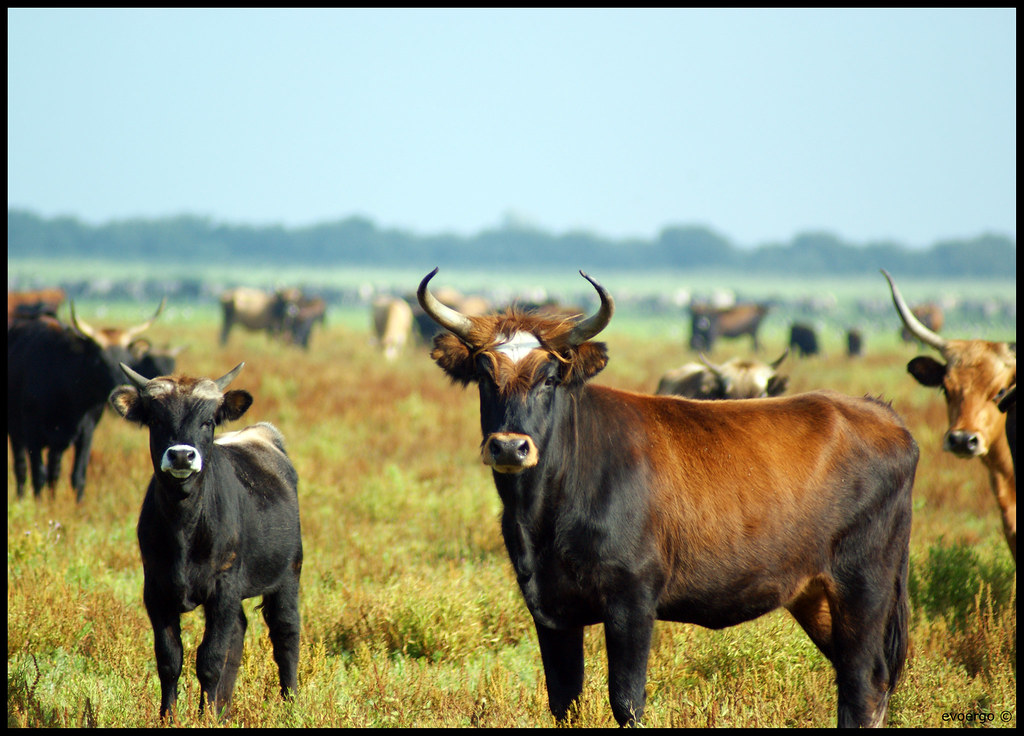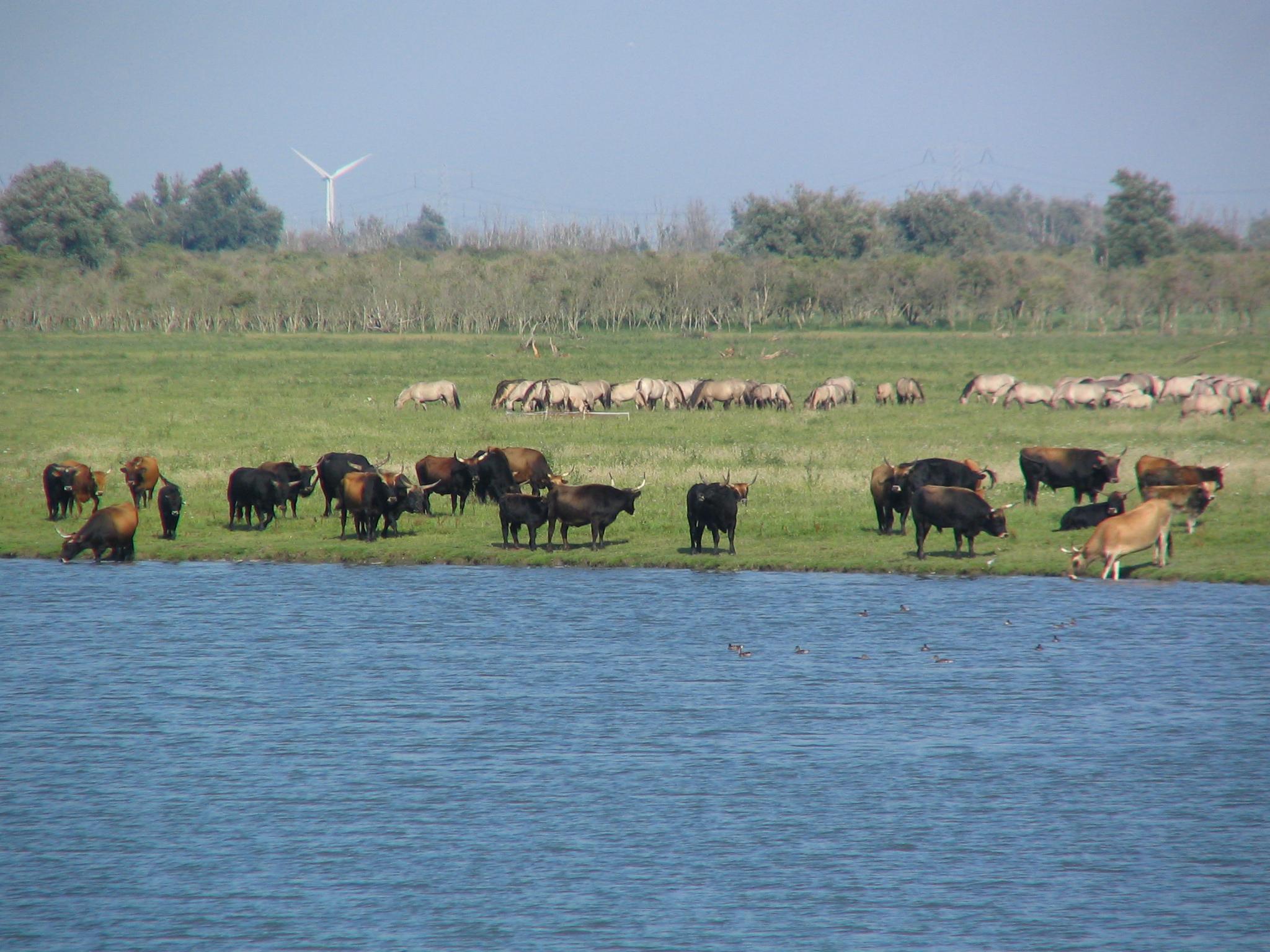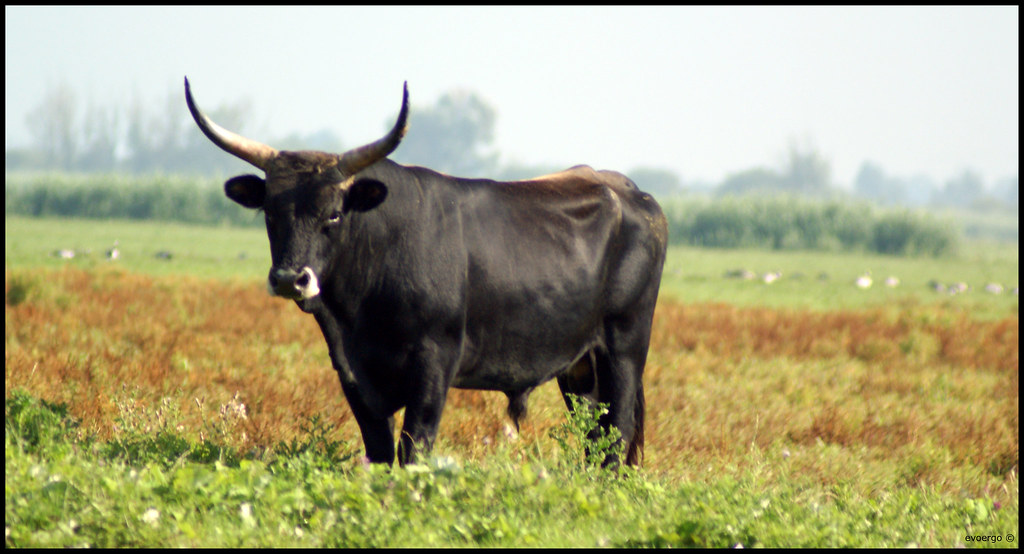I collected a number of recent photos of cattle in OVP that seem to endorse this hypothesis. Some of their phenotypic features are not apparent in any other Heck population or at least very rarely, so that we can assume that they are a product of natural selection. I suggest to those who have problems with this population because they are Heck cattle not to look at this herd as Heck cattle but as a mere cross population out of Hungarian Gray, Corsicana, Highland, Murnau-Werdenfelser, Braunvieh and so on, and that's what they actually basically are.
I posted this photo on my blog already some time ago, because it shows an animal with exceptional horns. While many of the other cows have upright, lyre-shaped horns, these face inwards and even the tips curve slightly upwards. The colour of this animal is nice too, apart from the spot on her face.
Look at the bull at your right. Its colour is not good and the legs do not look that long either, but the body is tight and muscular, and the hump is well-developed. Contrary to many other OVP bulls, the horns are quite long and thick.
I like this (subadult?) bull because of its correct colour and well-developed hump. The face and legs are short though. The horns are more upright than in the aurochs and have a rather straight shape, but they already show a tendency to face forwards and inwards compared to many other bulls in OVP. And look at the head of the cow at your right - the horns face forwards in an angle smaller than 90°; this is very rare in Hecks outside the reserve and was definitely not present in the starting population at OVP.
I covered these cows in a previous post already, but I'll do so again for completeness. The snouts are exceptionally long, like in some primitive-looking Sayaguesa or Pajuna. This is totally absent in any not-crossed Heck cattle. As I don't see any phenotypical advantages for that feature, I tentatively explain this with a pleiotropic effect as outlined above (note that I'm not an expert on this).
I posted that bull here already as well, but I am still amazed by it despite its tan colour and short upright horns. Look at the proportions and the body shape - it is as aurochs-like as in the most aurochs-like Lidia and such a body conformation is completely absent in any Heck bull outside OVP, even in Taurus bulls. The dewlap is very short as well.
Same horns as in the uppermost cow. Note the shaggy winter coat as well, the body and head are very domestic though.
This bull has aurochs-like proportions in having a pretty short trunk and long legs, and the body is muscular as well. The horns at least tend to face forwards a bit. The white spot is a pity.
Subadult bull in a bull herd, look at its short trunk and long legs. The body is tight and the waist is slender; the colour is good as well.
Neither the horns nor the body conformation are worth mentioning, but the colour is correctly aurochs-like and shows a nicely developed dimorphism. Could be a coincidence that an aurochs-coloured cow and an aurochs-coloured bull stand together at this photo, in which case this good colour isn't genetically fixed. But based on this photo we can assume that these two animals mated.
This cow is seen on many photos of OVP, and neither her body nor the skull or coat colour are good. But look at these horns - they are quite thick and curved in an aurochs-like manner.
The ashy colour and the short face aren't aurochs-like, but the short trunk with a deep ribcage and slender waist are. And the horns face more forwards than in many other cows in the reserve.
Perfect colour.
Ditto. And the horns face forwards in an angle only slightly larger than 90°, and the face is concave (primitive condition), a rare sight in Heck cattle.
The horns of the cow in the middle face forwards in a perfectly aurochs-like angle, no further comment is needed. The bull isn't bad-shaped either.
The left cow has aurochs-like horns (although not inwards-curving enough), and the cow next to it has a rather long skull (I think she's a beauty despite its black colour).
The bull at your right has a slender, aurochs-like trunk with a well-developed shoulder region and a slender rear. The horns face more forwards than in many other bulls.
At first sight, this little herd has not so impressing animals. But look at the bright colours that have a considerable portion of orange/red (with one annoying exception) and the fur is shiny. The sexual dimorphism is not very well-developed tough. If you take a closer look, some of the cattle show a tendency towards more aurochs-like horns.
Correct colour, long horns that - unfortunately - face only slightly forwards and inwards. Nicely shiny coat (by the way, why is a shiny coat worth mentioning in my opinion? It shows that the animal is well-nourished and therefore able to make use of the forage in the reserve effectively).
Look at the bull in the centre. Extremely tight-muscled, leg length is okay and the horns face forwards very well. Love it!
Horns facing slightly forwards, large head, small dewlap, tight-muscled body, good leg length and short trunk (I don't know why the back line is convex and if it has a functional advantage, but I saw it in other OVP bulls as well)
Neither the body conformation, the colour nor the proportions are worth mentioning, but the horns are pretty large and the curvature is better than lyre-shaped Gray cattle type horns.
And now a recent video of well-proportioned, well-horned and perfectly coloured bulls:
These aurochs-like features that are partly inherited by their founding breeds and partly produced by natural selection are split up among these individuals and there is not one cow and not one bull that unites all of them (I presume, I don't know each cattle in the reserve of course). But it is likely that in the following generations the individuals displaying such features make up an ever larger portion in the population, and thus more and more individuals will unite a larger number of these traits. It probably will take several decades until all aurochs-features currently present in the population will be fixed. But it is really exciting to watch this successive process and hopefully someone finally comes up with the idea of documenting it statistically.
Based on the traits that are presently apparent in the population, individuals uniting all those would have the proportions, body shape and proportions of the aurochs, horns resembling the aurochs to a certain degree. But the result would still be too small, and the sexual dimorphism in colour and size still have to be increased; this might happen in the future, with the probable exception of body size (more details on that in a future post).
But really I have considerable worries about the population because it faces several threats:
The propaganda by people who favour other breeds who want to replace any free-ranging Heck population with the cattle breeds they prefer is one of them. Replacing this cattle with other breeds which are considered more primitive would be really short-sighted because it would not appreciate the evident value of this population which is in a running dedomestication process that endorses the view that the aurochs' phenotypic feature do provide an evident fitness advantage, even such in which the advantage is not immediately apparent such as colour and snout length.
The second serious threat is the high population density and the resulting high mortality rates during winter. This would be less of a problem for the cattle if the rather - pardon - stupid decision to cull animals that appear skinny and suffering during winter to provide "needless suffering" would not decrease the cattle more severely than the horses because of their different digestive system (more on that in a post to come up). Horses seem to be better suited than cattle in cold, food-scarce environments than cattle because of their origin in the steppes and tundra, and the culling might even lead to the cattle being out-competed. I really, really hope that the cattle won't die out because of this mismanagement that was forced by clueless animal farewell activists.
For more posts on the interesting population at Oostvaardersplassen, see here:
- New aurochs head reconstruction and new photo from Oostvaardersplassen
- Aurochs horns at Oostvaardersplassen
- Heck cattle at Oostvaardersplassen - A special population





















I think this is a very interesting population and I agree that the population should be preserved. However I also think there should be gene flow between populations. If a few individuals were traded between herds it would allow the benefits of Auroch traits resulting from different experimental approaches to spread. It would also guard against the loss of progress that could result if any one population were temporarily extirpated. It would be great if the Taurus cattle of the Lippeaue in particular could be traded with the dedomesticated Hecks of the Oostvaardersplassen. Perhaps just a occasional bilateral exchange of 1 cow or bull. Eventually it would be nice if all breeding back and dedomestication experiments in cattle including TaurOs and Uruz could become one large metapopulation with low levels of genetic exchange between them. This could be especially interesting if we studied gene flow in the populations intensively. An extremely fit animal introduced into a less fit population should have a big impact, whereas an unfit animal would have little impact. Ultimately if the goal is a healthy population of wild cattle, phenotype and genotype are both a little bit beside the point- one of the most important goals should be the critical interaction of both that produces fitness. If at least some of the reserves participating in the exchange program had natural predation it could intensify the effects of natural selection.
ReplyDeleteHi,
ReplyDeleteI agree completely what you write and I had exactly the same thoughts. There are two major problems tough: 1) The Tauros/Uruz ideologists would never use a Heck-descended animal. Their goal is not, as you say, a large healthy metapopulation of aurochs-like cattle, but that they are praised as the only professional aurochs "reconstructers". So sadly they themselves are their priority and not the aurochs, but probably because they think they have the one and only key. 2) It is legally not possible to take the cattle from the reserve alive because of the EU laws on preventing the spread of bovine diseases and the cattle are not checked for diseases so they can only stay where they are. This is stupid. They are probably healthier than most domestic stock, and even if not each cattle that is chosen to be exported could be checked so the danger of spreading diseases would disappear. But no, it's forbidden. But nevermind, releasing a population of primitive cattle probably would result in an equally dedomesticated cattle strain in 20-30 years, and imagine what superiour animals would come out of this if really primitive animals are chosen.
Great piece! Your comments about the skinny cattle getting shot is largely untrue though. In all the blogs, articles, presentations etc. I have read and seen (in dutch) by the national forestry service (staatsbosbeer) rangers very consistently state that they can't tell the difference between healthy and unhealthy animals until the very end. The picture of a thin and a fat looking animal and the fat one ending up dying is very clear. That's why they only shoot at the point when it's clear that the animal will die, for instance when an animal sits down and doesn't move anymore. After reading this blog it makes sense though that a skinnier looking animal survives, more wildtype!
ReplyDelete